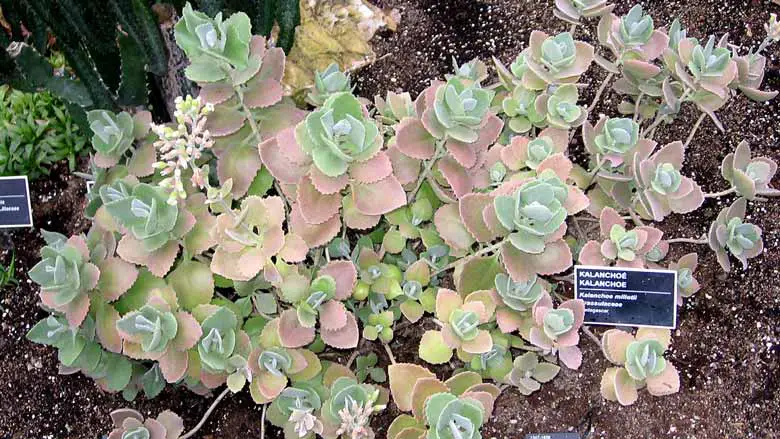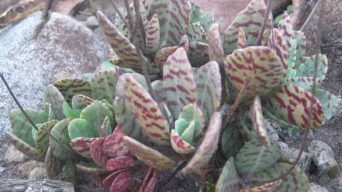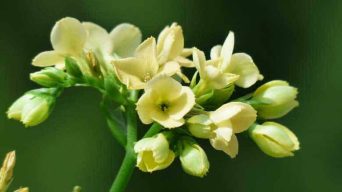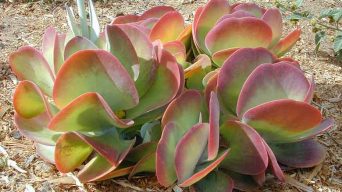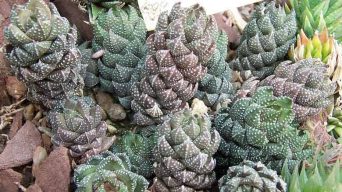The Kalanchoe millotii succulent plant is one that many people find interesting because of the unique and beautiful flowers it produces.
But, as with any other type of plant, there are some things you need to know in order to take care of your Kalanchoe plant properly.
This guide covers everything from proper watering and sunlight requirements to propagating new plants!
Overview
This succulent belongs to the Kalanchoe genus.
There are over 200 species of Kalanchoes worldwide. They vary in appearance by their leaf patterns, flower colors, plant size, stem shape, and other features such as thorns or spines.
Kalanchoe millotii is a part of the Crassulaceae family.
This species is native to Madagascar and can be cultivated as an ornamental succulent. It is typically grown indoors as it is not cold hardy.
Kalanchoe millotii, also known as Millot Kalanchoe, is a small succulent plant that grows to about one foot tall. The plants’ nature changes as they grow, from dense and bushy to branching.
The Kalanchoe millotii succulent plant has ovate leaves that have scalloped edges and a slightly fuzzy texture.
Kalanchoe millotii is a flowering succulent that has long, waxy leaves and clusters of tiny white flowers.
How To Care for Kalanchoe Millotii
Kalanchoe millotii care is easy to master.
This succulent plant is tough in the desert and can handle some frost, but it will not do well with full sun all day long or intense heat.
Let’s take a look at what you’ll need to know about Kalanchoe millotii care!
Sun Exposure & Light Requirements
The Kalanchoe millotii, like many succulents, prefers bright light.
They do not need to be in direct sunlight, but they should be close enough that the plant can see a window or exterior lighting during the day.
It is critical for this type of plant to get as much natural light as possible to thrive and survive indoors all year round.
Be sure to place your Kalanchoe millotii in a south-facing window that gets lots of light.
This type of plant can also thrive outside as long as it gets enough sun and the temperature does not go below 50 degrees Fahrenheit.
The Kalanchoe millotii requires six hours of bright sunlight per day but will do well with less if this isn’t possible at all times during its growth cycle.
Just be sure to rotate plants periodically to ensure they receive even levels of light throughout their lifetime.
Watering Requirements
Kalanchoe millotii plants also like to be watered regularly.
Soak the plant thoroughly for about a minute when you water it, and then wait until it is dry before watering again.
Be sure not to overwater this type of succulent as they are known to rot quickly due to high moisture levels in their soil.
Those who wonder how much they should water their Kalanchoe millotii succulent plant depend on where it lives.
Kalanchoe millotii succulents that live in low light conditions should be watered once every two weeks.
If you have a Kalanchoe millotii plant that lives in an area with intense sunlight, it would need to be watered about twice as often.
This is typically around once per week or so, depending on how much rain has been recently and the temperature of the region where your plant resides.
Soil Requirements
The Kalanchoe millotii will grow well with a well-draining potting mix such as a cactus mix or succulent soil mix.
The potting mix should be a combination of peat moss, perlite, and vermiculite.
If you want to use a soil mix, the Kalanchoe millotii will grow well in one that has a combination of peat moss, perlite, and vermiculite.
The Kalanchoe millotii needs a well-draining soil mix because it has no way to move water from its roots into the ground as most plants do, so poor drainage will cause it to rot, which can be fatal!
Temperature and Humidity
Kalanchoe millotii succulents are a tropical plant.
They require some humidity and warmth to thrive but not enough to grow mold or rot.
Their ideal temperature is 65- 80 degrees Fahrenheit (18- 27 C) during the day, with temperatures dropping down to 60 F at night.
It’s essential to keep Kalanchoe millotii plants at this temperature range. As below 55 F (13 C), the plant will not grow, and above 95 F (35 C), they may die.
Try to avoid letting them get too hot or cold. Move them away from any drafts in doors or windows that might cause different temperatures indoors than outdoors.
The ideal humidity levels for Kalanchoe millotii plants should be 50- 60% relative humidity (RH). Use a humidifier or other methods to increase the humidity level if it is too dry.
Fertilizing
Kalanchoe millotii requires little fertilizer, but it can be fertilized with a weak solution of diluted organic fertilizer.
Do not fertilize more than once every six weeks, as too much fertilizer can cause root rot, harming the plants.
Once the plant is well established and no new leaves are budding from the stem, it will need more frequent feeding.
The best time for this is in spring when plants start to grow again actively or if you live in an area with cool winters where Kalanchoe millotii succulents go dormant during that season.
Wait until all visible traces of frost have disappeared before fertilizing your Kalanchoe millotii succulent plant again.
Potting and Repotting
When potting, ensure you have a light soil type that drains well because this plant loses moisture quickly.
One option for your pot is to use moss pebbles instead of sand or gravel since they allow more water drainage without losing nutrients.
You can also replant in fresh soil every year if it will result in healthier growth but take extra care when handling not to damage the sensitive roots, which may lead to root rot.
Kalanchoe millotii plants need to be repotted every year to maintain healthy growth.
Repotting is necessary because the soil mix will become compacted and not provide sufficient drainage, leading to root rot or fungal problems.
Repotting should be done during early spring before new growth starts. Remove all old soil down to its original level and leave some space at the top of the container.
Add some fresh soil and make sure to water it thoroughly for the best results.
Pruning
Kalanchoes are pretty low-maintenance plants.
When they start to overgrow their pot, those with many leaves will need some pruning to maintain the plant’s health and beauty.
The most common time for this is during spring or fall when you can cut off as much excess growth as desired without stressing out the plant too much.
If your Kalanchoe millotii has an abundance of flowers at any given time, then it may be necessary to trim back everything but one flower head from each stalk.
This provides more energy for blooming, which helps keep them healthy throughout the summertime.
When Kalanchoes get leggy (long and thin and without much foliage), it’s a sign that the plant needs more light and water.
If you want your Kalanchoe millotii to stay in shape, it is important to trim it back when it gets too long or leggy.
Prune Kalanchoes by removing unwanted leaves from around the base of the plant with sharp scissors.
Pests and Diseases
Kalanchoe millotii has a few pests or diseases that need to be taken care of.
Scale
The scale insect may sometimes infest the plant and can cause leaves to turn yellow as they suck sap from them.
This pest is easy enough to control with a strong spray of water.
Scale insects are most often found near windows where there is lots of sun exposure. So it might not affect your Kalanchoe millotii plants if you put them indoors instead.
Mildew
If mildew appears on your Kalanchoe millotii, try spraying some neem oil on the affected area once weekly until the mildew disappears completely (which should take about two weeks).
Thrips
If you find that the Kalanchoe millotii is being eaten, it may be because of an infestation with thrips.
This pest can also cause leaves to turn yellow and look ragged as they suck sap from them.
To get rid of thrips on your plants, try spraying a strong mixture of water mixed with soap (or neem oil) once per week for two weeks to kill any adults or larva present.
Aphids
If aphids are present on the plant, first use a spray bottle full of soapy water to wash away eggs and other pests.
Then repeat this every few days until there are no more signs of aphid activity.
Snails
If snails are eating the plant, try to keep them out of your garden to prevent further damage.
Ensure that there are no leaves on the ground where they can hide and be protected from predators.
Mealybugs
If mealybugs invade your Kalanchoe millotii plants, then use neem oil mixed with some soap (or insecticidal soap) once per week for two weeks to get rid of them.
Overwatering
If yellowing leaves result from overwatering, try cutting back on watering time.
If you know it was only recently watered (within an hour or so), wait a few hours before giving it more water again.
However, if the plant is still looking droopy and wilted after being given plenty to drink for several days in a row, it may have been receiving too much sunlight.
It can benefit from moving into some partial shade with fresh air circulation around its roots.
How to Care for Kalanchoe Millotii in Winter
Kalanchoe millotii succulents require a lot of care during winter.
Kalanchoe plants are sensitive to cold, so they should be taken indoors.
They can handle some sun, but not too much, as it will burn them.
If you already have Kalanchoe millotii succulents at home, the plant might recover if it is kept away from direct sunlight for a few days and gets plenty of water.
It’s best to move the Kalanchoe pot outdoors on sunny days when temperatures allow it.
You can also keep the plant in front of an east-facing window with only indirect light coming through the glass.
When moving your Kalanchoes outside, make sure that their pots have good drainage!
Covering the soil with a paper towel layer will help prevent water from remaining in the pot.
Kalanchoe care includes keeping this species warm during winter in mild climates.
If you want your Kalanchoe millotii to overwinter, then a dark place with little light and cool temperatures are best.
The ideal temperature range for Kalanchoe Millotii winter care is 45-50 degrees Fahrenheit (approximately 20C/-30C).
Put the plant on its pot in an area with good air circulation, such as near a window or heater vent where there are no drafts.
How To Propagate Kalanchoe Millotii
Kalanchoe millotii succulents can be propagated by leaf and stem cuttings.
Leaf-cutting propagation requires less effort and time than propagating them by stems.
Although, both methods produce healthy plants when using high-quality leaves or branches pruned in spring (before new growth appears).
You need to remove the cuttings from the mother plant. Use a sharp knife or scissors to make the cut clean.
Allow the cuttings to callous and dry for a day.
Then, put the cuttings in a pot with well-draining succulent soil in bright indirect light. Keep it moist until new growth appears (usually within two weeks).
When propagating by stems, use softwood from spring plants.
Cut about six inches of stem for each cutting using sharp pruning shears or knives to make the cuts clean.
Trim off any leaves but leave small root buds at the joint where you cut them from the mother plant.
Dip fresh ends in a rooting hormone before planting them on top of your chosen container filled with a good quality succulent mix that drains quickly.
Place them under bright shade away from direct sunlight and keep them watered often enough until they start showing signs of life (new root tips peaking out).
Is the Kalanchoe Millotii Toxic?
The Kalanchoe millotii can be toxic to people and animals.
When ingested, it can cause nausea, diarrhea, and vomiting.
The plant also contains cardiac glycosides, which are found in the leaves of many plants.
However, there have been no reports of human fatalities caused by ingestion or handling of the Kalanchoe millotii. Most parts are not poisonous to humans.
Only a tiny portion includes these toxic substances in its tissues.
As with any other succulent, be sure to wash your hands after touching this plant, and not accidentally ingest anything harmful on accident.
Final Thoughts
Kalanchoe millotii is a low-maintenance succulent plant that doesn’t require too much attention.
Kalanchoe millotii care is straightforward.
It’s also easy to propagate, making it an excellent choice for those looking to expand their garden collection of plants or for gift giving.

